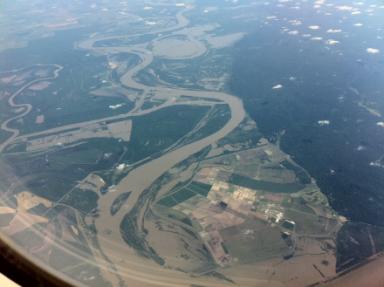Following is a travelogue from a New Orleans trip we took in May of this year to attend the AIA Convention. I never finished it, but Hurricane Irene and watching the first season of Treme from Netflicks reminded me, so here it is several months late.
From Fayetteville, we flew to New Orleans on May 11 for the American Institute of Architects (AIA) annual convention. It was my second trip to the Big Easy since Katrina in 2005 (Report on a Week in New Orleans, November 13, 2005).
I am happy to report that New Orleans continues to recover from both Katrina and the economic impact of the BP Oil disaster. One presentation I attended at the AIA convention was on New Orleans’ new general plan. An interesting statistics indicated the number of households in New Orleans is back to the pre-Katrina level, but the population is only about 60%, meaning that lots of families with children did not return. The City of New Orleans is optimistic about future growth.
The first night we had dinner with Olivier Baugnies de Saint Marceaux at Café Degas. Olivier is an architect and a French native married to a New Orleans native. I made his acquaintance on the Internet while surfing the web trying to match up some locations in my father’s old WWII photos to current conditions. Although an infantry officer, my father was also a lawyer, and when sent to Europe in 1944 a few months after my birth, he was assigned as a legal specialist in foreign claims. He disembarked at Omaha Beach in Normandy in August, 1944, a couple of months after D-Day, and then followed the front through France and Belgium where he commanded a small detachment (Claims Office, Team 6816) settling claims of Europeans against the American military. He moved from place to place through northwestern France and eventually into southern Belgium until the war ended in the spring of 1945.
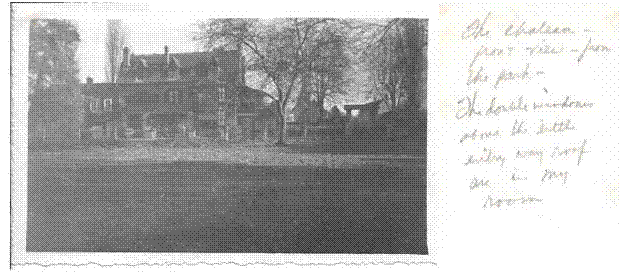
One of places my father stayed briefly was a tiny village in Normandy called Cuy-Saint-Fiacre. Above is a photo of his billet, which he called “The Chateau.”
This is kind of a shaggy dog story, but the upshot is that earlier this year I was trying to piece together some of may father’s WWII experiences in France and Belgium based on old photos, and using Google Earth and other sources. I could not locate the “Chateau,” but I did, however, find old postcards on the Internet with the same building he called “The Chateau” identified as “Chalet de St. Marceaux.” A little more research indicated that it was the home a famous French 19th and early 20th Century sculptor Charles René de Saint-Marceaux, born in Reims, Marne and died in Paris in 1915. There are twenty-four works of St. Marceaux listed in the Musee d'Orsay catalogue by Saint-Marceaux dating from 1869 onwards.
I sent some emails to village officials in Cuy-Saint-Fiacre trying to find out what happened to the building, and eventually I got a response from Olivier Baugnies de Saint Marceaux. Someone had forwarded him one of my emails . He is the step-grandson of Charles René de Saint-Marceaux and had lived on the property before the Chalet de St. Marceaux was torn down in the 1960s. He said that it got a lot of wear and tear during WWII from which it never recovered. His family sold the property in the 1950s. Olivier said it had been occupied by first the French army, then the German army and finally the American army. The French, he said, was the worst, doing more damage than the Americans and Germans combined.
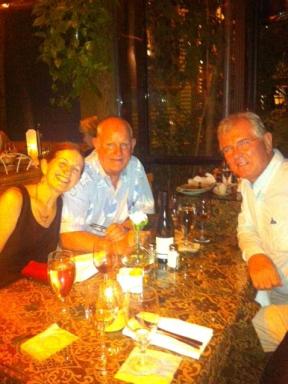
Above, Shirley, Tom and Olivier at Cafe Degas Below Charles René de Saint-Marceaux (1845-1915)
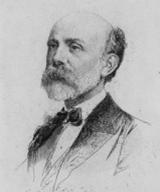
All the time I was corresponding with him, I assumed he was in France. When he found out we were headed to New Orleans, he surprised me by inviting us to dinner. Café Degas is owned by two Frenchmen who are friends of Olivier.
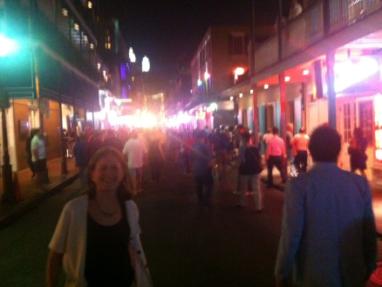
Above, After dinner, we strolled through the French Quarter, finding Bourbon Street as crowded and noisy as ever.
Below, Riverwalk looking over the Mississippi River at flood stage.
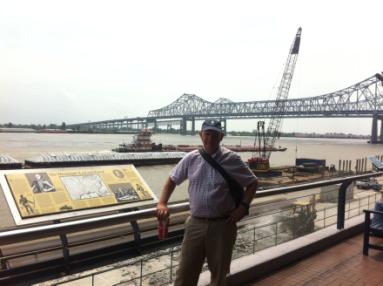
The AIA keynote speaker on Thursday morning was Thomas L. Friedman, an internationally renowned author, reporter, and columnist—the recipient of three Pulitzer Prizes and the author of five bestselling books, among them From Beirut to Jerusalem and The World Is Flat. He talked largely from his latest book, Hot, Flat and Crowded, which shows how 9/11, Hurricane Katrina, and the flattening of the world by the Internet (which brought 3 billion new consumers onto the world stage) have combined to bring climate and energy issues to Main Street. But they have not gone very far down Main Street; the much-touted "green revolution" has hardly begun. With all that in mind, Friedman sets out the clean-technology breakthroughs we, and the world, will need; he shows that the ET (Energy Technology) revolution will be both transformative and disruptive; and he explains why America must lead this revolution—with the first Green President and a Green New Deal, spurred by the Greenest Generation.
Below, The AIA Expo, about 12 football fields of construction exhibits.
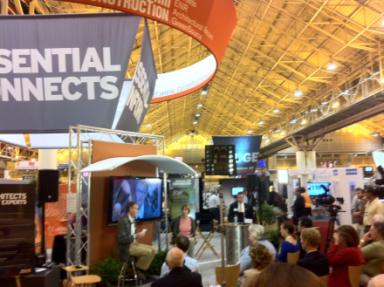
After Friedman, the remaining keynoters were unremarkable as were most of the sessions I attended to rack up continuing education credits. But New Orleans was, as always, a visual and gustatory treat.
The Mississippi River was at flood stage, about 3 feet below the top of the levee at 17 feet, and a great attraction to waterfront visitors. The opening of floodgates upriver was intended to keep the level at New Orleans at or below 17 feet.
On Thursday evening, we ate at another outstanding restaurant, Irene’s Cuisine, with some college friends of Shirley. It was loud and crowded, but the food was remarkable.
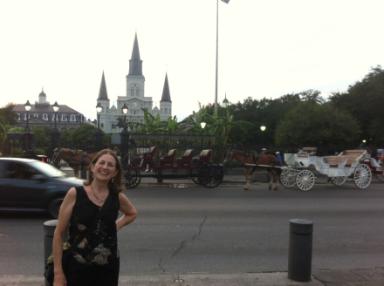
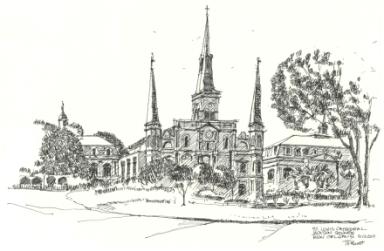
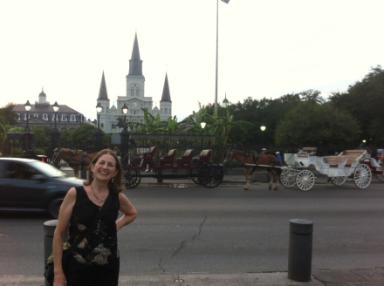
On Friday, I took some time off from the convention to do a little sketching. One of the great American public spaces is Jackson Square (above). I had first sketched this over 40 years ago when I visited New Orleans from Ft. Polk when I was in the army. I gave the sketch to a friend and found out only recently that it had been destroyed by vandals years later when her late parents’ home was burglarized.
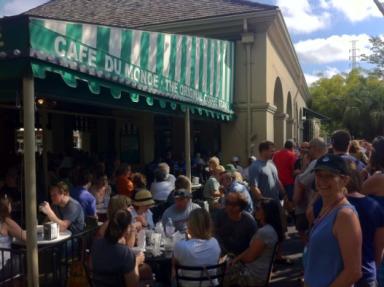
Above, Café du Monde. Below, Shirley preparing to attack crayfish.
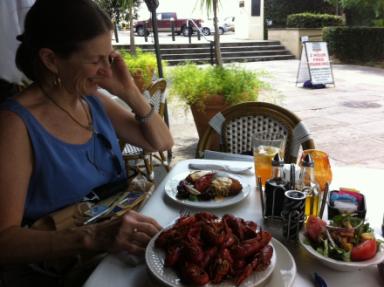
The Original Cafe Du Monde Coffee Stand was established in 1862 in the New Orleans French Market. The Cafe is open 24 hours a day, seven days a week. It closes only on Christmas Day and on the day an occasional Hurricane passes too close to New Orleans. Eating is synonymous with New Orleans as is tradition, so we had bieignets at Café du Mond for breakfast and boiled crawfish at another French market café for lunch.
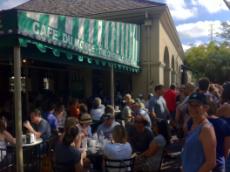
Meanwhile, I toiled away at my continuing education credits and marveled at the acres of building products in the convention exhibits.
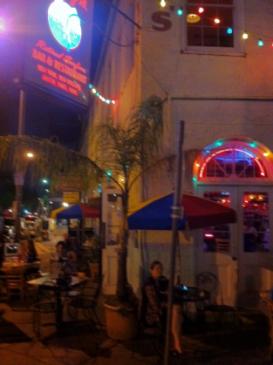
Above, dinner in the Warehouse District. Below, lunch in a restaurant courtyard .
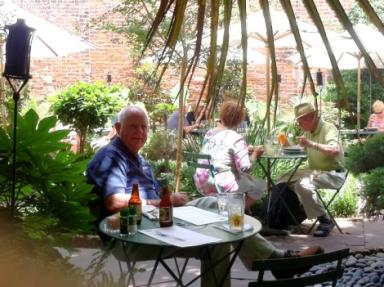
Before we left, I knocked out a couple more sketches, one of a Creole cottage in the Marigny District (east of the French Quarter) and one of Lafitte’s Blacksmith Shop Bar on Bourbon Street. I stayed at a friend’s apartment next door to Lafitte’s in February of 1969 for a couple of weeks before leaving for Vietnam We took in Mardi Gras, and during the day I went to the Clay Shaw Trial. Clay Shaw had been accused of conspiracy in the Kennedy assassination and was brought to trial by colorful New Orleans DA Jim Garrison. Garrison later wrote a book about his investigation of the JFK assassination and the subsequent trial called On the Trail of the Assassins. This book served as one of the main sources for Oliver Stone's movie JFK. In the movie, this trial serves as the back story for Stone's account of the assassination of John F. Kennedy.
As you might imagine, the trial was a huge media event, and the courtroom was packed. I got to talking with a bailiff, and after I told him why I was in New Orleans, he told me to come wearing my uniform every day, and he would guarantee me a seat. The trial was great drama, but the jury found Shaw not guilty.
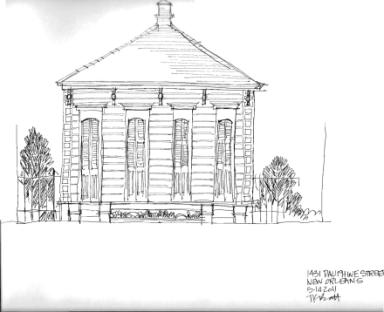
Above, Creole cottage in the Marigny District (east of the French Quarter) and, below, Lafitte’s Blacksmith Shop Bar on Bourbon Street.
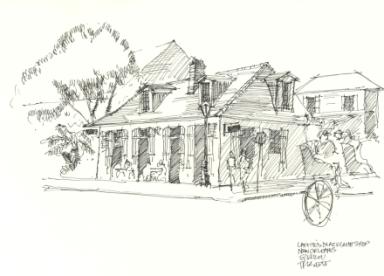
On the last night we took the streetcar named St. Charles (not Desire) out to Tulane and back. The route traditionally forms a 13.2-mile crescent from Carondelet at Canal Street in the Central Business District through the oldest and most majestic section of uptown New Orleans, around the Riverbend to Carrollton at Claiborne Avenue. Swaying along St. Charles Avenue through a tunnel Live Oaks, the streetcar passes dozens of antebellum mansions, historic monuments, Loyola and Tulane universities, the sweeping grounds of the Audubon Zoological Gardens, shopping centers, fine restaurants and hotels.
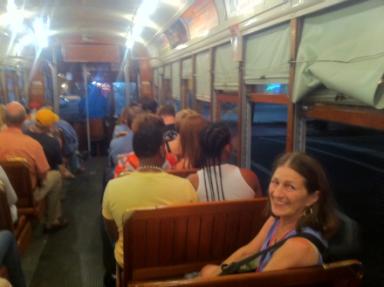
On the flight to Los Angeles to accept the City’s historic preservation award for the Civic Center (See http://www.tombutt.com/forum/2011/110518a.htm), we could see where the floodgates had been opened to relieve the engorged Mississippi and save the city of New Orleans.
